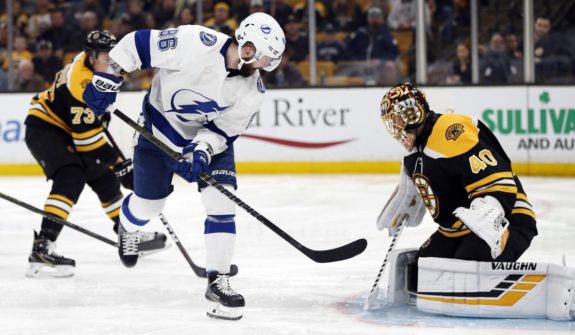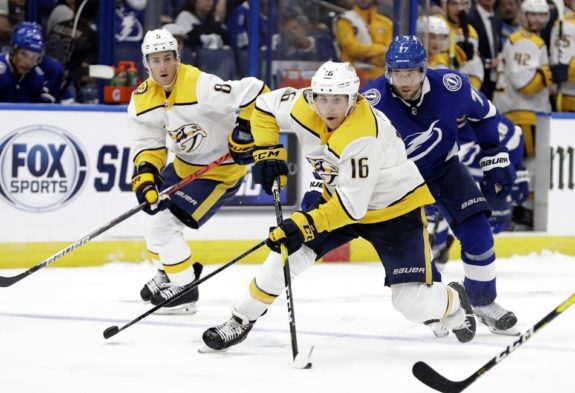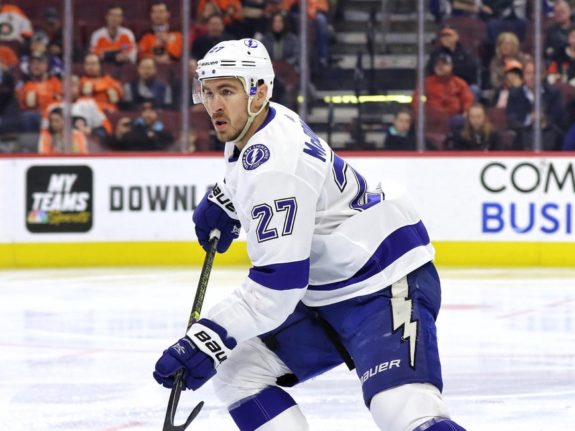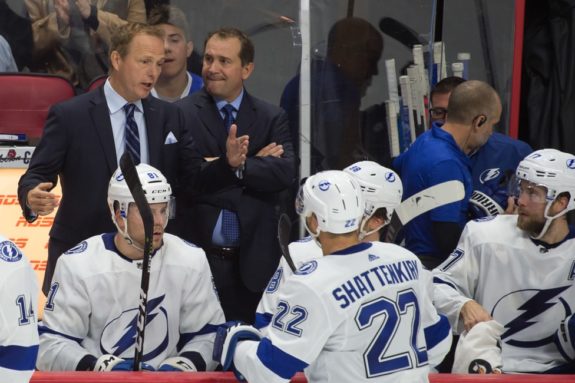Another week of Tampa Bay Lightning hockey is in the books, and all things considered, it went fairly well. They managed to eke out a 3-2 win against the Pittsburgh Penguins Wednesday night, and on Saturday night they got one point in an overtime loss to the Nashville Predators.
As it stands right now, the Lightning are fourth in the Atlantic Division with 12 points, sitting behind the Buffalo Sabres, Boston Bruins and Toronto Maple Leafs. They still have a winning record and have the second wildcard spot — which, at this point in the season, is essentially meaningless — but it’s been a lot of the same on both hands so far. The Lightning are still taking a boatload of penalties without a strong shorthanded unit, and they’re relying on goaltender Andrei Vasilevskiy to bail them out, which he has done thus far.
Related: Bolts Breakdown: Undisciplined and Inconsistent to Start the Season
The Lightning have struggled to find consistency and pay attention to detail this season. Let’s break it down.
The Good
Great Goaltending
Neither of the Lightning’s two goalies have spectacular numbers, but much of that can be attributed to power play opportunities for the opposition. Vasilevskiy currently has a .907 save percentage (SV%) and a 2.99 goals against average (GAA), both of which are significant steps down from his Vezina Trophy numbers last year. Curtis McElhinney has a .915 SV% and 3.29 GAA, but he’s had some tough breaks in overtime so far this season. But, if they didn’t show up against the Penguins and Predators this week, the Lightning surely would have been winless.
Vasilevskiy robbed the Penguins of tying the game in the last seconds of the third period with a miraculous glove save on the goal line. He also made a huge save on a breakaway for Sam Lafferty that kept the Lightning in front 1-0 at the time. Against the Predators, McElhinney made a handful of big saves in the second period to keep the game tied and give his team a chance to get the lead. Ultimately it was penalties that came between him and his first win in a Lightning uniform.
Vasilevskiy was a big reason the Lightning held on to win against the Penguins, and he’s the backbone of the team. When he’s on, he’s almost impossible to beat. McElhinney played well and deserved a better fate than he was given. Both goalies are a big reason the Lightning had three points instead of none.
Shooting The Puck
Through their first six games, NHL.com reported the Lightning had the fewest average shots per game in the NHL (25.7) and allowed the third-most in the league (34.2). Against the Penguins on Wednesday, they allowed 39 shots on goal but had 48 for themselves, 39 of which were at even strength. They only had 30 to the Predators’ 40 on Saturday, but as Dave Mishkin indicates, that doesn’t reflect how well they played without the puck.

The Lightning were outshot 79-78 for the week, but the point is they’re shooting more and creating more chances. In 2017-18, they averaged a franchise record 32.7 shots per game, and last year they averaged 32 shots a game. Since their sixth game of the season, they’re averaging 40 shots per game and 3.5 goals per game. They’re on the right track and if they can keep it up, they should find the back of the net more often.
The Captain
As the captain of the Lightning, Steven Stamkos is the heartbeat of the team. He serves as the bridge between the locker room and the coaches office, but also as an example — both on and off the ice — for how his teammates should conduct themselves. When he needs to, he will tell his teammates how it is, but for the most part, he’s a lead-by-example captain, and he’s done just that this season.

Stamkos has 11 points — five goals and six assists — through 10 games this season, including five points in the Lightning’s last five games. We know he can score, but it’s his play beyond scoring that stands out. He’s currently winning 59% of his faceoffs, which is 6% higher than all of last season and 10% better than his career average. Against the Penguins, Stamkos had one assist, four shots on goal, two hits, one block and a faceoff percentage of 58%. Against the Predators, he had a goal, three shots on goal and a 75% faceoff percentage. He’s helping the team on both sides of the puck and is a true leader in every sense of the word.
The Bad
Penalty Problems
The Lightning played arguably their sloppiest game against the Colorado Avalanche on Oct. 19 when they took 18 penalty minutes — two five-minute fighting majors and four minor penalties — but against the Penguins, they seemed to turn it around. They only took one minor penalty and held off the Penguins’ power play while scoring one power play goal of their own in four opportunities. However, when the Predators came to town, the Lightning fell into penalty trouble once again.

Both of the Predators’ goals in regulation time came on the power play. If the Lightning hadn’t taken those penalties, they would have had a much better chance of winning, but the worst part was the type of penalties taken. They took a hold, a trip and a cross-checking penalty, but they took two bench minor penalties for having too many men on the ice. The last one was in overtime and the Predators capitalized with the game-winning goal.
Related: Bolts Breakdown: Shattenkirk, Poor Defense and High-Danger Chances
Penalties will happen, but bench minor penalties are easily avoidable infractions by paying attention to detail. As the Lightning learned last year, doing the little things help win you a championship, and multiple bench minor penalties only make the route tougher.
Killing the Penalties
The Lightning have taken a ton of penalties this season, but one thing that’s different compared to last year is their penalty killing. Through their first 10 games, they have been shorthanded 36 times — tied for 12th in the league — and have a penalty-kill percentage of 69.4%. The only teams worse than them are the Montreal Canadiens (68.6%) and the Winnipeg Jets (64%).

The Lightning have deployed their normal shorthanded corps this season — Ryan McDonagh, Erik Cernak, Alex Killorn and Anthony Cirelli — while Ondrej Palat, Victor Hedman and Kevin Shattenkirk have also seen time on the kill. They also recently got back forward Cedric Paquette, a player who has never shied away from blocking shots and making hits.
The difference this year is simply execution. The players on the penalty kill, for the most part, have been chasing the puck and pulling themselves out of position. This gives the opposing power play easy chances at the net and leaves Vasilevskiy or McElhinney out to dry. If they can be more structured and get sticks in the passing lanes, the shorthanded units will see better success.
And, as I’ve stated before, they could just take less penalties, but everyone knows that’s easier said than done.
Overall Consistency
In general this season, the Lightning just haven’t found any sort of consistency, especially over the last two weeks. They had a huge win against the Boston Bruins on Oct. 17, but the Avalanche came to town and walked all over them. The Lightning won a solid 3-2 game against the Penguins on Wednesday, and while they played well against the Predators, their special teams let them down and had to settle for one point.

The bottom line is finding as much consistency as possible. Limit the penalties, play a well-structured game, forecheck hard and create offensive opportunities. The only game where they have put all of those together was against the Maple Leafs on Oct. 10.
The Lightning are still a good team, but they’re shooting themselves in the foot with penalties, execution and attention to detail. If they can clean those things up, they have a chance to return to the top of the Atlantic Division and the Eastern Conference.